Business Case for IT Solution at St. Cuthbert's Healthcare, MAN6935
VerifiedAdded on 2022/08/01
|8
|1568
|25
Report
AI Summary
This report analyzes the IT challenges faced by St. Cuthbert's Healthcare, a non-profit hospital system in Australia. It identifies issues such as lack of enabling technologies, medical errors, and the slow adoption of medical advancements. The report proposes an IT solution: Avanade's Intelligent Marketing and Engagement for Providers, to address these challenges. This solution aims to improve patient engagement, streamline communication, facilitate patient care, and leverage AI for personalized outreach. The report outlines the solution's functions, implementation considerations, and potential risks, emphasizing the importance of adhering to healthcare ethics principles. The analysis demonstrates how the proposed IT solution can drive digital transformation and improve the overall performance of St. Cuthbert's Healthcare, ultimately improving patient outcomes.
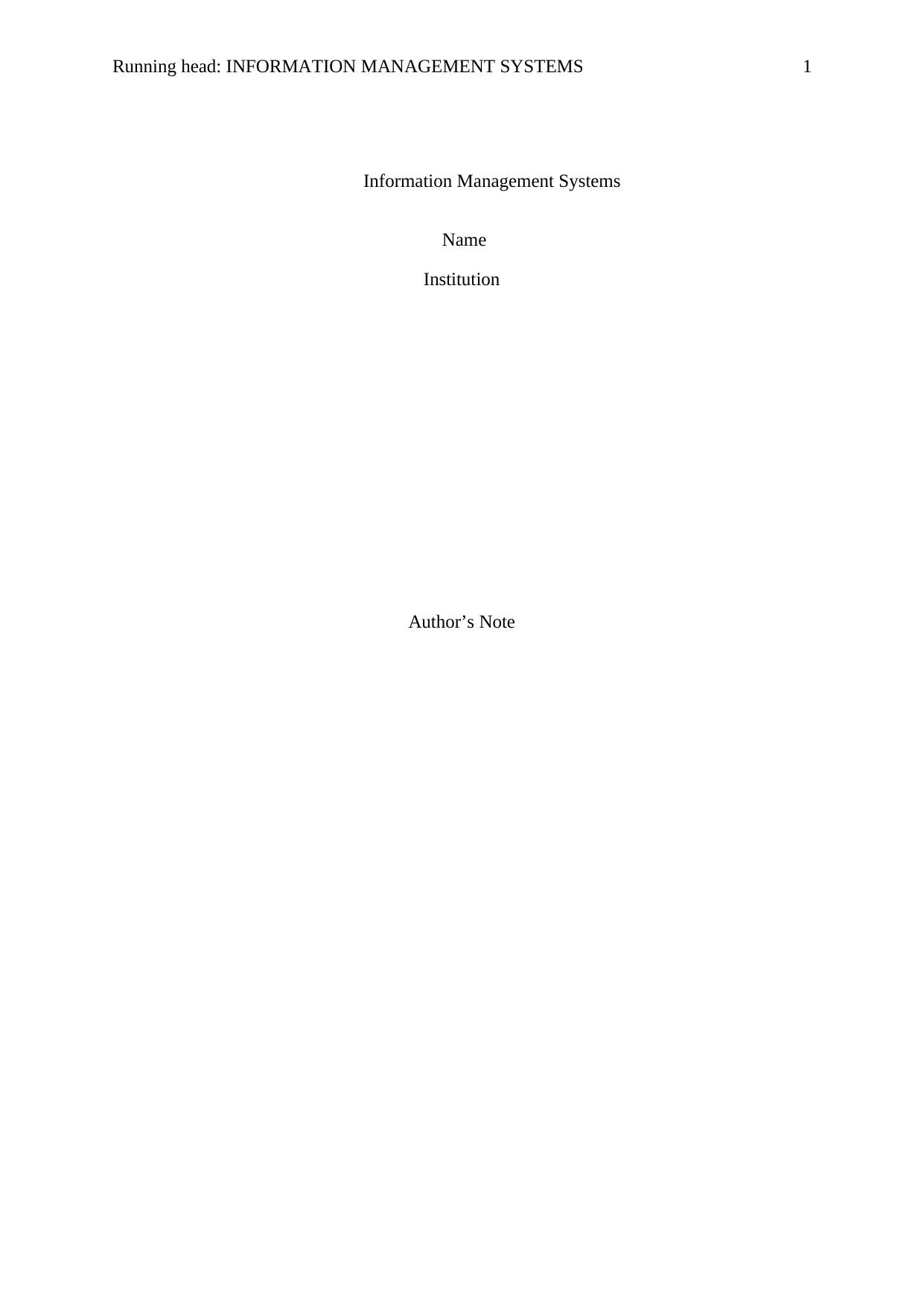
Running head: INFORMATION MANAGEMENT SYSTEMS 1
Information Management Systems
Name
Institution
Author’s Note
Information Management Systems
Name
Institution
Author’s Note
Paraphrase This Document
Need a fresh take? Get an instant paraphrase of this document with our AI Paraphraser
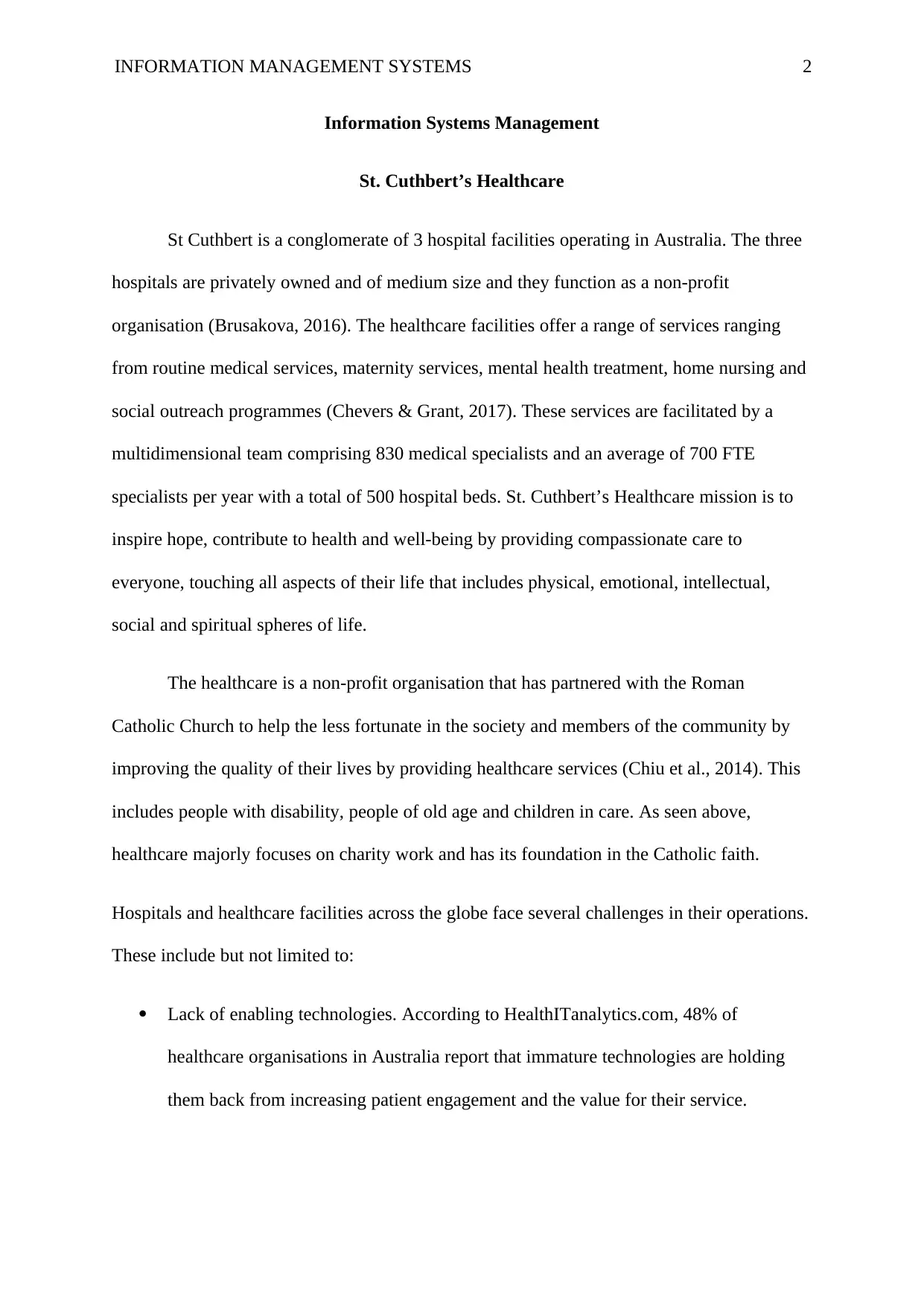
INFORMATION MANAGEMENT SYSTEMS 2
Information Systems Management
St. Cuthbert’s Healthcare
St Cuthbert is a conglomerate of 3 hospital facilities operating in Australia. The three
hospitals are privately owned and of medium size and they function as a non-profit
organisation (Brusakova, 2016). The healthcare facilities offer a range of services ranging
from routine medical services, maternity services, mental health treatment, home nursing and
social outreach programmes (Chevers & Grant, 2017). These services are facilitated by a
multidimensional team comprising 830 medical specialists and an average of 700 FTE
specialists per year with a total of 500 hospital beds. St. Cuthbert’s Healthcare mission is to
inspire hope, contribute to health and well-being by providing compassionate care to
everyone, touching all aspects of their life that includes physical, emotional, intellectual,
social and spiritual spheres of life.
The healthcare is a non-profit organisation that has partnered with the Roman
Catholic Church to help the less fortunate in the society and members of the community by
improving the quality of their lives by providing healthcare services (Chiu et al., 2014). This
includes people with disability, people of old age and children in care. As seen above,
healthcare majorly focuses on charity work and has its foundation in the Catholic faith.
Hospitals and healthcare facilities across the globe face several challenges in their operations.
These include but not limited to:
Lack of enabling technologies. According to HealthITanalytics.com, 48% of
healthcare organisations in Australia report that immature technologies are holding
them back from increasing patient engagement and the value for their service.
Information Systems Management
St. Cuthbert’s Healthcare
St Cuthbert is a conglomerate of 3 hospital facilities operating in Australia. The three
hospitals are privately owned and of medium size and they function as a non-profit
organisation (Brusakova, 2016). The healthcare facilities offer a range of services ranging
from routine medical services, maternity services, mental health treatment, home nursing and
social outreach programmes (Chevers & Grant, 2017). These services are facilitated by a
multidimensional team comprising 830 medical specialists and an average of 700 FTE
specialists per year with a total of 500 hospital beds. St. Cuthbert’s Healthcare mission is to
inspire hope, contribute to health and well-being by providing compassionate care to
everyone, touching all aspects of their life that includes physical, emotional, intellectual,
social and spiritual spheres of life.
The healthcare is a non-profit organisation that has partnered with the Roman
Catholic Church to help the less fortunate in the society and members of the community by
improving the quality of their lives by providing healthcare services (Chiu et al., 2014). This
includes people with disability, people of old age and children in care. As seen above,
healthcare majorly focuses on charity work and has its foundation in the Catholic faith.
Hospitals and healthcare facilities across the globe face several challenges in their operations.
These include but not limited to:
Lack of enabling technologies. According to HealthITanalytics.com, 48% of
healthcare organisations in Australia report that immature technologies are holding
them back from increasing patient engagement and the value for their service.
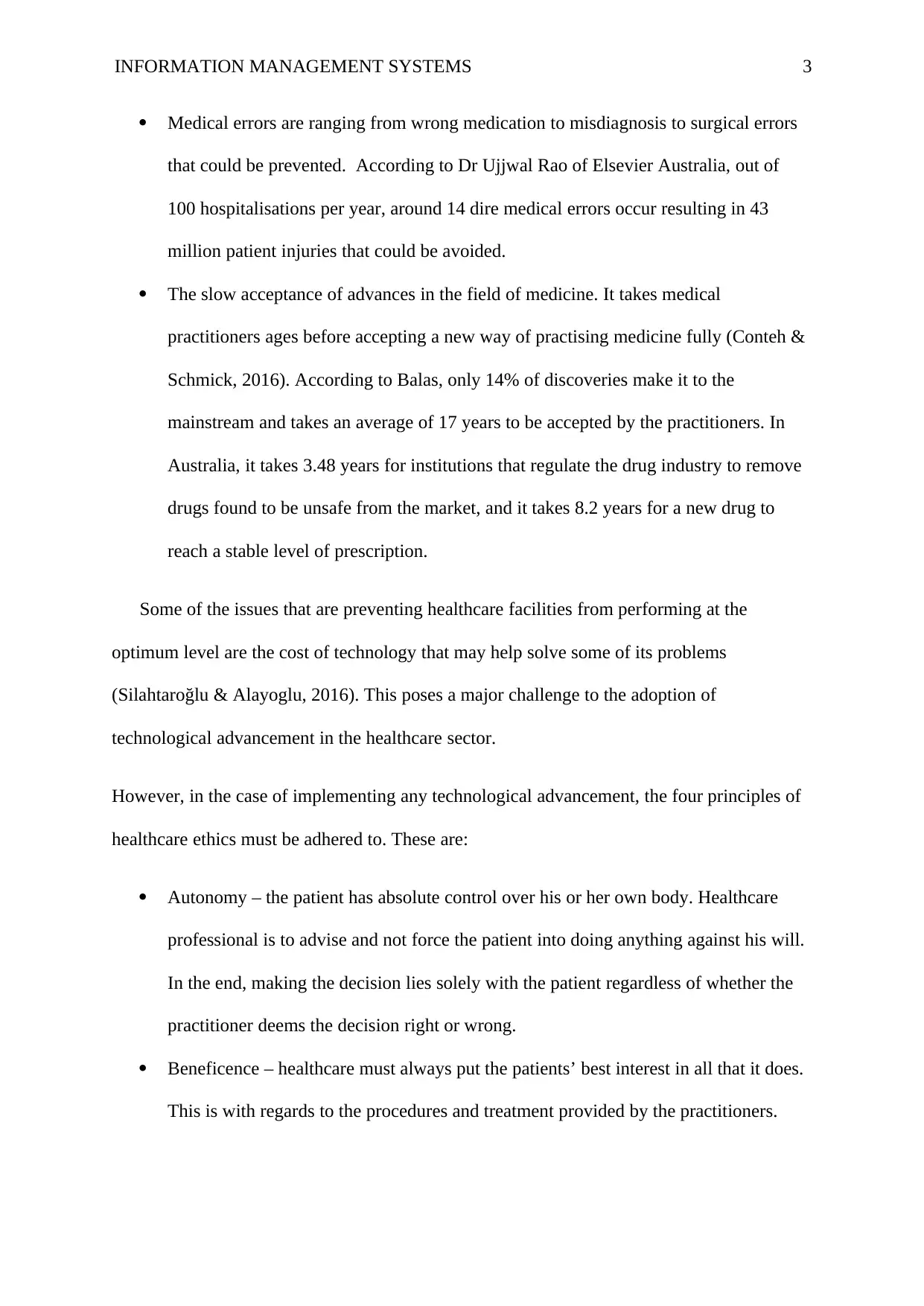
INFORMATION MANAGEMENT SYSTEMS 3
Medical errors are ranging from wrong medication to misdiagnosis to surgical errors
that could be prevented. According to Dr Ujjwal Rao of Elsevier Australia, out of
100 hospitalisations per year, around 14 dire medical errors occur resulting in 43
million patient injuries that could be avoided.
The slow acceptance of advances in the field of medicine. It takes medical
practitioners ages before accepting a new way of practising medicine fully (Conteh &
Schmick, 2016). According to Balas, only 14% of discoveries make it to the
mainstream and takes an average of 17 years to be accepted by the practitioners. In
Australia, it takes 3.48 years for institutions that regulate the drug industry to remove
drugs found to be unsafe from the market, and it takes 8.2 years for a new drug to
reach a stable level of prescription.
Some of the issues that are preventing healthcare facilities from performing at the
optimum level are the cost of technology that may help solve some of its problems
(Silahtaroğlu & Alayoglu, 2016). This poses a major challenge to the adoption of
technological advancement in the healthcare sector.
However, in the case of implementing any technological advancement, the four principles of
healthcare ethics must be adhered to. These are:
Autonomy – the patient has absolute control over his or her own body. Healthcare
professional is to advise and not force the patient into doing anything against his will.
In the end, making the decision lies solely with the patient regardless of whether the
practitioner deems the decision right or wrong.
Beneficence – healthcare must always put the patients’ best interest in all that it does.
This is with regards to the procedures and treatment provided by the practitioners.
Medical errors are ranging from wrong medication to misdiagnosis to surgical errors
that could be prevented. According to Dr Ujjwal Rao of Elsevier Australia, out of
100 hospitalisations per year, around 14 dire medical errors occur resulting in 43
million patient injuries that could be avoided.
The slow acceptance of advances in the field of medicine. It takes medical
practitioners ages before accepting a new way of practising medicine fully (Conteh &
Schmick, 2016). According to Balas, only 14% of discoveries make it to the
mainstream and takes an average of 17 years to be accepted by the practitioners. In
Australia, it takes 3.48 years for institutions that regulate the drug industry to remove
drugs found to be unsafe from the market, and it takes 8.2 years for a new drug to
reach a stable level of prescription.
Some of the issues that are preventing healthcare facilities from performing at the
optimum level are the cost of technology that may help solve some of its problems
(Silahtaroğlu & Alayoglu, 2016). This poses a major challenge to the adoption of
technological advancement in the healthcare sector.
However, in the case of implementing any technological advancement, the four principles of
healthcare ethics must be adhered to. These are:
Autonomy – the patient has absolute control over his or her own body. Healthcare
professional is to advise and not force the patient into doing anything against his will.
In the end, making the decision lies solely with the patient regardless of whether the
practitioner deems the decision right or wrong.
Beneficence – healthcare must always put the patients’ best interest in all that it does.
This is with regards to the procedures and treatment provided by the practitioners.
⊘ This is a preview!⊘
Do you want full access?
Subscribe today to unlock all pages.

Trusted by 1+ million students worldwide
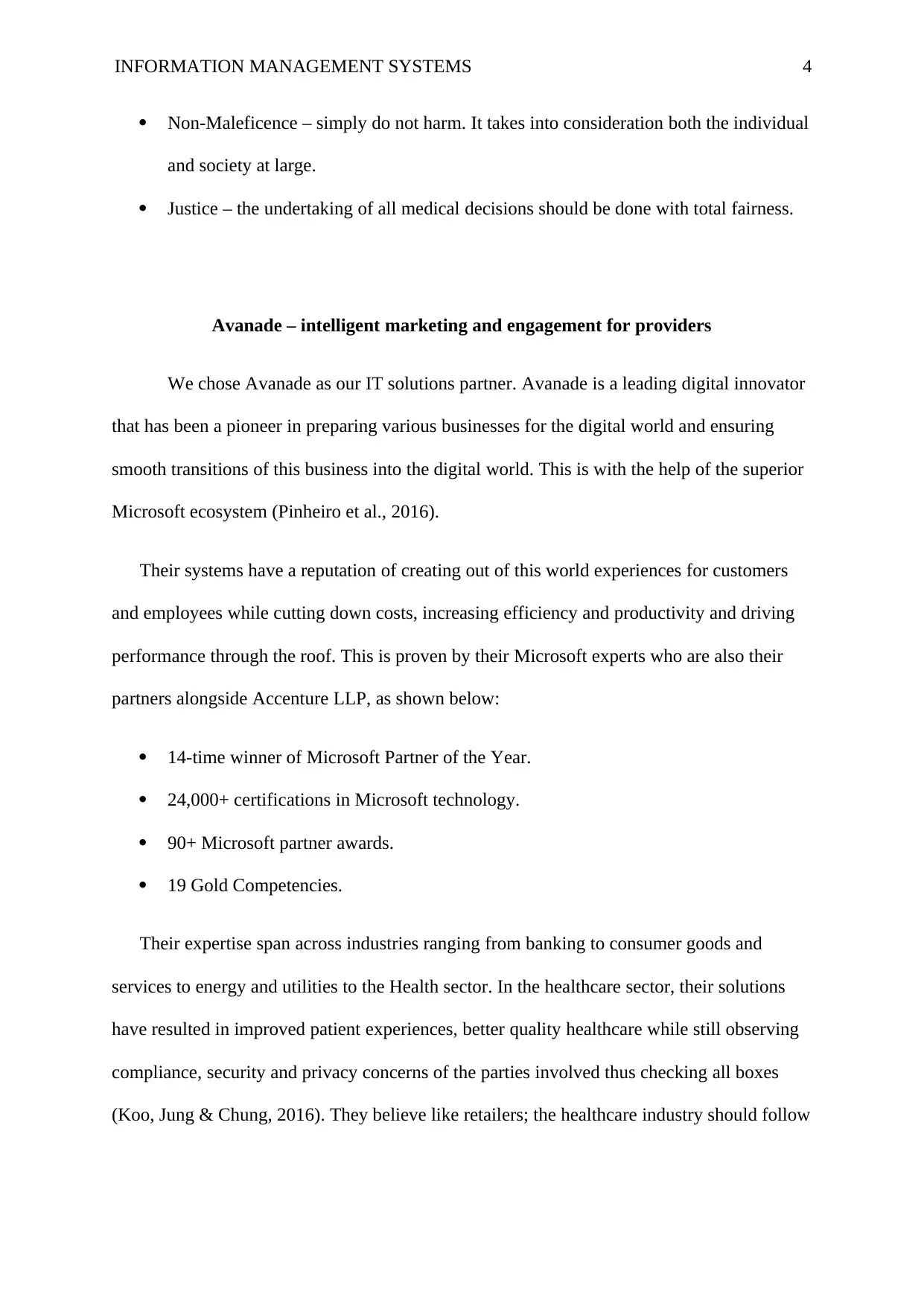
INFORMATION MANAGEMENT SYSTEMS 4
Non-Maleficence – simply do not harm. It takes into consideration both the individual
and society at large.
Justice – the undertaking of all medical decisions should be done with total fairness.
Avanade – intelligent marketing and engagement for providers
We chose Avanade as our IT solutions partner. Avanade is a leading digital innovator
that has been a pioneer in preparing various businesses for the digital world and ensuring
smooth transitions of this business into the digital world. This is with the help of the superior
Microsoft ecosystem (Pinheiro et al., 2016).
Their systems have a reputation of creating out of this world experiences for customers
and employees while cutting down costs, increasing efficiency and productivity and driving
performance through the roof. This is proven by their Microsoft experts who are also their
partners alongside Accenture LLP, as shown below:
14-time winner of Microsoft Partner of the Year.
24,000+ certifications in Microsoft technology.
90+ Microsoft partner awards.
19 Gold Competencies.
Their expertise span across industries ranging from banking to consumer goods and
services to energy and utilities to the Health sector. In the healthcare sector, their solutions
have resulted in improved patient experiences, better quality healthcare while still observing
compliance, security and privacy concerns of the parties involved thus checking all boxes
(Koo, Jung & Chung, 2016). They believe like retailers; the healthcare industry should follow
Non-Maleficence – simply do not harm. It takes into consideration both the individual
and society at large.
Justice – the undertaking of all medical decisions should be done with total fairness.
Avanade – intelligent marketing and engagement for providers
We chose Avanade as our IT solutions partner. Avanade is a leading digital innovator
that has been a pioneer in preparing various businesses for the digital world and ensuring
smooth transitions of this business into the digital world. This is with the help of the superior
Microsoft ecosystem (Pinheiro et al., 2016).
Their systems have a reputation of creating out of this world experiences for customers
and employees while cutting down costs, increasing efficiency and productivity and driving
performance through the roof. This is proven by their Microsoft experts who are also their
partners alongside Accenture LLP, as shown below:
14-time winner of Microsoft Partner of the Year.
24,000+ certifications in Microsoft technology.
90+ Microsoft partner awards.
19 Gold Competencies.
Their expertise span across industries ranging from banking to consumer goods and
services to energy and utilities to the Health sector. In the healthcare sector, their solutions
have resulted in improved patient experiences, better quality healthcare while still observing
compliance, security and privacy concerns of the parties involved thus checking all boxes
(Koo, Jung & Chung, 2016). They believe like retailers; the healthcare industry should follow
Paraphrase This Document
Need a fresh take? Get an instant paraphrase of this document with our AI Paraphraser
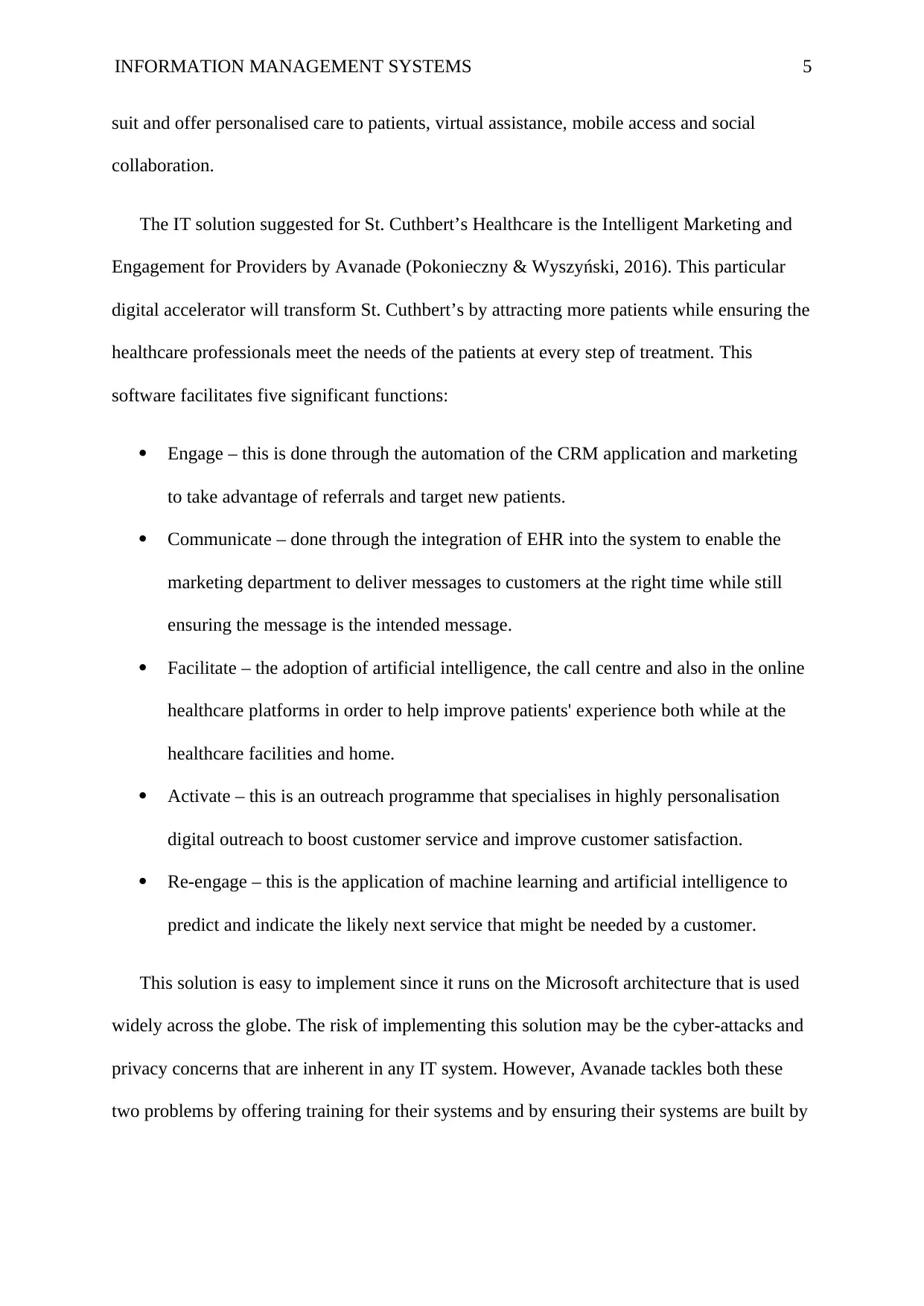
INFORMATION MANAGEMENT SYSTEMS 5
suit and offer personalised care to patients, virtual assistance, mobile access and social
collaboration.
The IT solution suggested for St. Cuthbert’s Healthcare is the Intelligent Marketing and
Engagement for Providers by Avanade (Pokonieczny & Wyszyński, 2016). This particular
digital accelerator will transform St. Cuthbert’s by attracting more patients while ensuring the
healthcare professionals meet the needs of the patients at every step of treatment. This
software facilitates five significant functions:
Engage – this is done through the automation of the CRM application and marketing
to take advantage of referrals and target new patients.
Communicate – done through the integration of EHR into the system to enable the
marketing department to deliver messages to customers at the right time while still
ensuring the message is the intended message.
Facilitate – the adoption of artificial intelligence, the call centre and also in the online
healthcare platforms in order to help improve patients' experience both while at the
healthcare facilities and home.
Activate – this is an outreach programme that specialises in highly personalisation
digital outreach to boost customer service and improve customer satisfaction.
Re-engage – this is the application of machine learning and artificial intelligence to
predict and indicate the likely next service that might be needed by a customer.
This solution is easy to implement since it runs on the Microsoft architecture that is used
widely across the globe. The risk of implementing this solution may be the cyber-attacks and
privacy concerns that are inherent in any IT system. However, Avanade tackles both these
two problems by offering training for their systems and by ensuring their systems are built by
suit and offer personalised care to patients, virtual assistance, mobile access and social
collaboration.
The IT solution suggested for St. Cuthbert’s Healthcare is the Intelligent Marketing and
Engagement for Providers by Avanade (Pokonieczny & Wyszyński, 2016). This particular
digital accelerator will transform St. Cuthbert’s by attracting more patients while ensuring the
healthcare professionals meet the needs of the patients at every step of treatment. This
software facilitates five significant functions:
Engage – this is done through the automation of the CRM application and marketing
to take advantage of referrals and target new patients.
Communicate – done through the integration of EHR into the system to enable the
marketing department to deliver messages to customers at the right time while still
ensuring the message is the intended message.
Facilitate – the adoption of artificial intelligence, the call centre and also in the online
healthcare platforms in order to help improve patients' experience both while at the
healthcare facilities and home.
Activate – this is an outreach programme that specialises in highly personalisation
digital outreach to boost customer service and improve customer satisfaction.
Re-engage – this is the application of machine learning and artificial intelligence to
predict and indicate the likely next service that might be needed by a customer.
This solution is easy to implement since it runs on the Microsoft architecture that is used
widely across the globe. The risk of implementing this solution may be the cyber-attacks and
privacy concerns that are inherent in any IT system. However, Avanade tackles both these
two problems by offering training for their systems and by ensuring their systems are built by
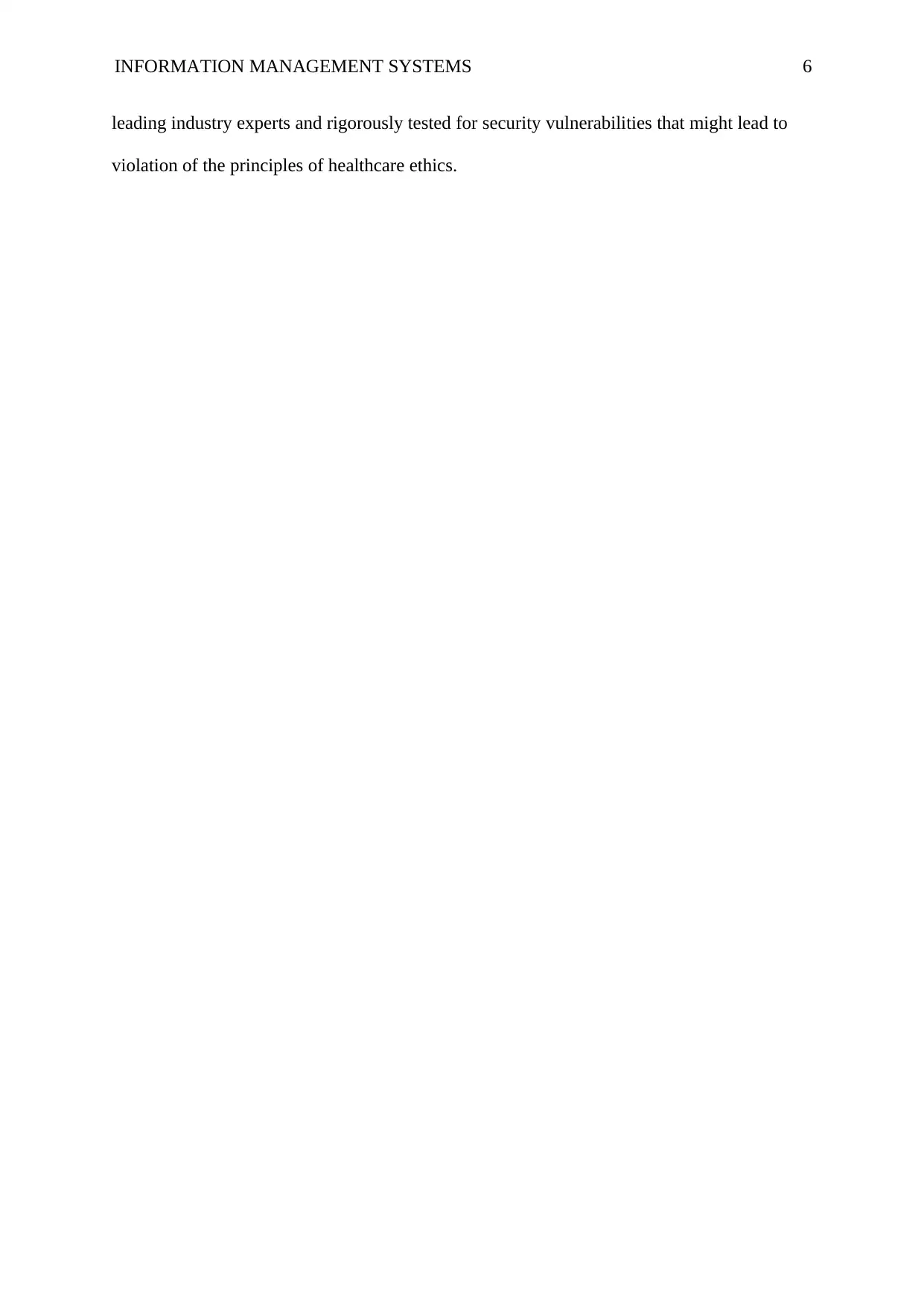
INFORMATION MANAGEMENT SYSTEMS 6
leading industry experts and rigorously tested for security vulnerabilities that might lead to
violation of the principles of healthcare ethics.
leading industry experts and rigorously tested for security vulnerabilities that might lead to
violation of the principles of healthcare ethics.
⊘ This is a preview!⊘
Do you want full access?
Subscribe today to unlock all pages.

Trusted by 1+ million students worldwide
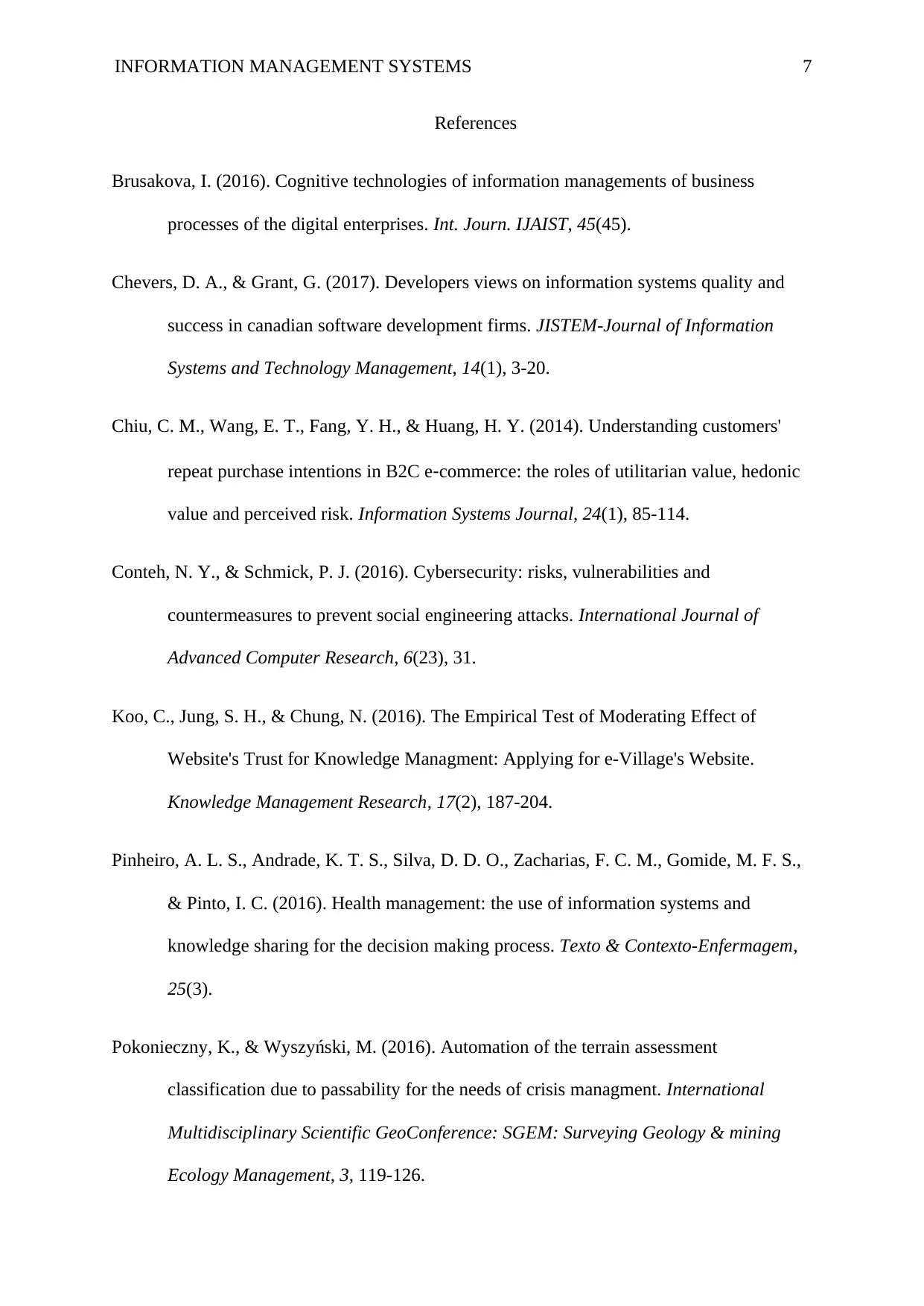
INFORMATION MANAGEMENT SYSTEMS 7
References
Brusakova, I. (2016). Cognitive technologies of information managements of business
processes of the digital enterprises. Int. Journ. IJAIST, 45(45).
Chevers, D. A., & Grant, G. (2017). Developers views on information systems quality and
success in canadian software development firms. JISTEM-Journal of Information
Systems and Technology Management, 14(1), 3-20.
Chiu, C. M., Wang, E. T., Fang, Y. H., & Huang, H. Y. (2014). Understanding customers'
repeat purchase intentions in B2C e‐commerce: the roles of utilitarian value, hedonic
value and perceived risk. Information Systems Journal, 24(1), 85-114.
Conteh, N. Y., & Schmick, P. J. (2016). Cybersecurity: risks, vulnerabilities and
countermeasures to prevent social engineering attacks. International Journal of
Advanced Computer Research, 6(23), 31.
Koo, C., Jung, S. H., & Chung, N. (2016). The Empirical Test of Moderating Effect of
Website's Trust for Knowledge Managment: Applying for e-Village's Website.
Knowledge Management Research, 17(2), 187-204.
Pinheiro, A. L. S., Andrade, K. T. S., Silva, D. D. O., Zacharias, F. C. M., Gomide, M. F. S.,
& Pinto, I. C. (2016). Health management: the use of information systems and
knowledge sharing for the decision making process. Texto & Contexto-Enfermagem,
25(3).
Pokonieczny, K., & Wyszyński, M. (2016). Automation of the terrain assessment
classification due to passability for the needs of crisis managment. International
Multidisciplinary Scientific GeoConference: SGEM: Surveying Geology & mining
Ecology Management, 3, 119-126.
References
Brusakova, I. (2016). Cognitive technologies of information managements of business
processes of the digital enterprises. Int. Journ. IJAIST, 45(45).
Chevers, D. A., & Grant, G. (2017). Developers views on information systems quality and
success in canadian software development firms. JISTEM-Journal of Information
Systems and Technology Management, 14(1), 3-20.
Chiu, C. M., Wang, E. T., Fang, Y. H., & Huang, H. Y. (2014). Understanding customers'
repeat purchase intentions in B2C e‐commerce: the roles of utilitarian value, hedonic
value and perceived risk. Information Systems Journal, 24(1), 85-114.
Conteh, N. Y., & Schmick, P. J. (2016). Cybersecurity: risks, vulnerabilities and
countermeasures to prevent social engineering attacks. International Journal of
Advanced Computer Research, 6(23), 31.
Koo, C., Jung, S. H., & Chung, N. (2016). The Empirical Test of Moderating Effect of
Website's Trust for Knowledge Managment: Applying for e-Village's Website.
Knowledge Management Research, 17(2), 187-204.
Pinheiro, A. L. S., Andrade, K. T. S., Silva, D. D. O., Zacharias, F. C. M., Gomide, M. F. S.,
& Pinto, I. C. (2016). Health management: the use of information systems and
knowledge sharing for the decision making process. Texto & Contexto-Enfermagem,
25(3).
Pokonieczny, K., & Wyszyński, M. (2016). Automation of the terrain assessment
classification due to passability for the needs of crisis managment. International
Multidisciplinary Scientific GeoConference: SGEM: Surveying Geology & mining
Ecology Management, 3, 119-126.
Paraphrase This Document
Need a fresh take? Get an instant paraphrase of this document with our AI Paraphraser
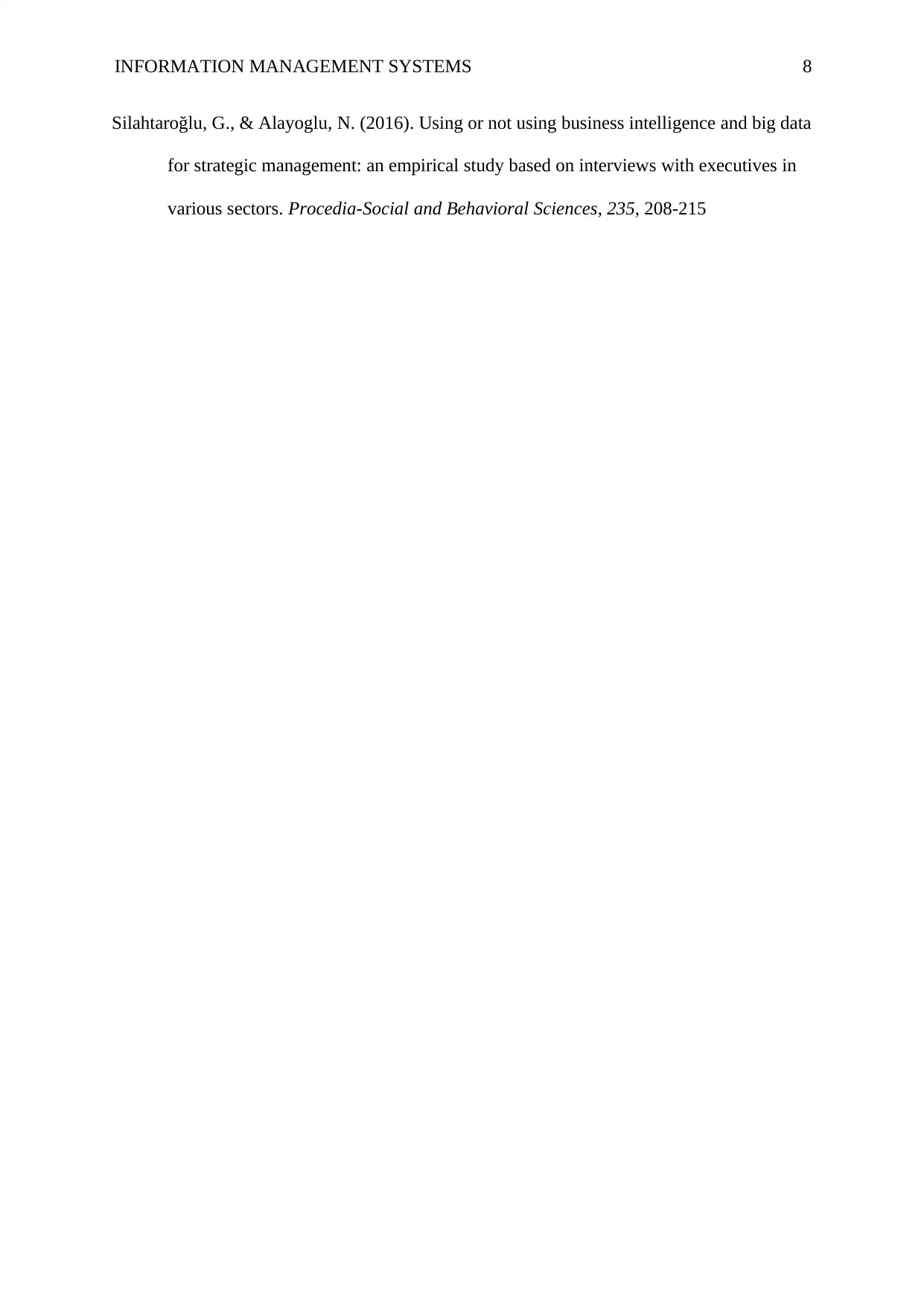
INFORMATION MANAGEMENT SYSTEMS 8
Silahtaroğlu, G., & Alayoglu, N. (2016). Using or not using business intelligence and big data
for strategic management: an empirical study based on interviews with executives in
various sectors. Procedia-Social and Behavioral Sciences, 235, 208-215
Silahtaroğlu, G., & Alayoglu, N. (2016). Using or not using business intelligence and big data
for strategic management: an empirical study based on interviews with executives in
various sectors. Procedia-Social and Behavioral Sciences, 235, 208-215
1 out of 8
Related Documents
Your All-in-One AI-Powered Toolkit for Academic Success.
+13062052269
info@desklib.com
Available 24*7 on WhatsApp / Email
![[object Object]](/_next/static/media/star-bottom.7253800d.svg)
Unlock your academic potential
Copyright © 2020–2025 A2Z Services. All Rights Reserved. Developed and managed by ZUCOL.





